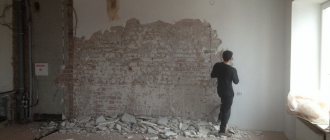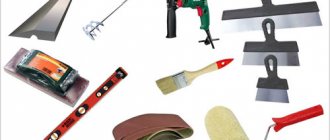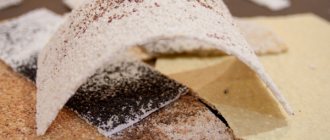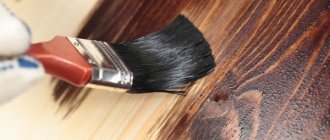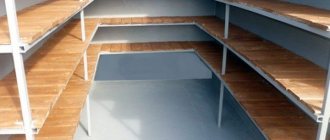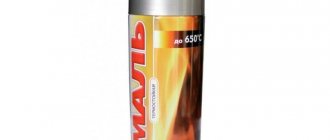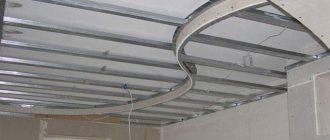There is an opinion that it is possible to paint brick walls and cover them with plaster mixtures without prior priming, since the brick itself adheres well to the above materials.
In general, this opinion is only half correct, since brick surfaces can be treated without using a primer only with mixtures that contain primer additives (this includes primer dyes, primer varnishes and primer putties).
If the finishing material used does not contain such components, any surfaces, including brick, must be coated with primers, otherwise they will crack in a short time, the facing materials will begin to crumble and peel off.
Types and characteristics of primers for exterior use
The quality of facade finishing depends most on the correct preparation of the base. Without this, even the most expensive paints and decorative plasters will not give the expected effect. Particular attention should be paid to priming the surface - a simple, but very important stage. What is a facade primer, how to choose it correctly, and what is it actually needed for?
Peculiarities
Silicate primer penetrates deeply well. It perfectly fills pores, microcracks, and after complete crystallization fills them.
Important! When treated with silicate primer, the surface is ready to accept only silicate finishing (paint, plaster). There is no other option.
Silicate primer can be used as a thinner for plasters and paints. It is strictly prohibited to apply it to plaster.
How to choose soil for a brick wall
Before choosing soil you must:
- pay attention to the condition of the brick wall;
- determine the type of brick (facing, ordinary);
- find out the material from which the brick is made (clay, silicate, hyper-pressed, aerated concrete);
- find out the finishing material that will go on the wall.
All these factors will help determine the type of primer mixture. It is also worth considering future operating parameters. Will it be a dry or wet room. Where will the primer be applied: outside or inside the building.
Selection of primer mixture in accordance with finishing materials
Plaster mortars or paints are used to decorate brick walls. In any case, the use of deep penetration primers will be justified.
When painting brick walls that are made of facing bricks, you can limit yourself to universal primers. But in cases where paint is used to finish the facade, it is necessary to use moisture-resistant, deeply penetrating primers for exterior work.
Technology for plastering a brick wall in photo and video examples
Plastering a brick wall is most often done with the goal of leveling the surface and compensating for differences in level. This work is relatively not difficult; the mortar on the brick, due to the texture of the latter, holds up very well. Almost any working composition is suitable here.
In this article we will look at the technologies of beacon and beaconless plaster. We will also touch upon the issue of choosing a suitable mixture.
- Plaster on brick. Process technology and selection of working personnel
- Preparatory work
- Technology of façade plastering on brick: lighthouse method
- Lightless plaster on brick
- Which plaster is better for brick walls: choosing a mixture
Plaster on brick. Process technology and selection of working personnel
If subsequent finishing is expected with a geometric pattern on the surface, it is better to work according to beacons. This is the only way to make the surface perfectly smooth.
Preparatory work
Old partitions should be tapped to check for crumbling areas. If there are any, we hollow them out until a homogeneous material is exposed. Then we go over the entire wall with a steel brush, removing the remaining crumbs of brick and concrete. If the masonry is new, then it will not require special preparation. It will be enough to remove dust from the surface. How to prime a brick wall before plastering? It is better to choose a hydrophobic, deeply penetrating composition.
How to choose the right soil mixture
When choosing a primer for treating walls, you need to consider:
- Basic components. Soil mixtures for sand-lime and simple bricks will differ in properties. For smooth sand-lime bricks, adhesive compounds are used before painting or applying plaster.
- Condition of the material. For an old, cracked or crumbling wall, it is necessary to use strengthening primers, preferably deep penetration, before applying a decorative coating.
- Location of walls. For facade walls or in wet rooms (bathroom, kitchen or bathhouse), purchase a primer with increased moisture-repellent and antiseptic properties. For simple or porous bricks, it is recommended to use moisture-resistant mixtures of deep penetration.
In addition, you need to take into account the chemical composition of the primer:
- Acrylic water-soluble or silicone-based are suitable for most brick walls, environmentally friendly, do not have a strong odor and dry quickly.
- Water-dispersed ones are usually represented by deep penetration primers. They provide high-quality adhesion and strengthen the base of the walls. They can be used before applying any topcoat.
- Alkyds fit well on any brick base, ensuring subsequent even wallpaper gluing and high-quality painting. Alkyd primers are not recommended to be applied before plastering. Some plasters enter into a “chemical conflict” with the alkyd component and this affects the further quality of the finish.
- Mineral compositions - based on cement, lime or gypsum. They fit well on any brick, provide high-quality adhesion and protection from external conditions. Often, deep penetration mineral mixtures are used to improve the strength properties of walls outside and inside buildings. Non-toxic, environmentally friendly. These primers can be used before any decoration.
- Universal ones are convenient to use for complex repairs of small areas consisting of materials of different structures. To work only on a brick base, it is recommended to use specialized soil solutions.
Which priming solution to choose: deep penetration or regular and what active component it has, everyone must decide for themselves when purchasing. If you have difficulty making a choice, it is better to seek advice from sales consultants at a hardware store.
Types of primers
There are several types of soil for aerated concrete blocks. They are selected individually, as they have multiple differences.
Note! Some types of primer (fireproof, filler, alkyd) indicated in the table are given as informational material. Not applicable to aerated concrete walls.
With hydrophobic additives
The film-forming composition has the property of sharply reducing the water-absorbing qualities of the aerated block. Thanks to the formation of a thin protective film, it prevents the penetration of moisture from the atmosphere as a result of precipitation, including slanting rain. Increases vapor permeability to the outside rather than inside the building. Has adhesive (cohesive) properties.
Standard
The emulsion has a narrow focus. Its application to the gas block helps improve the adhesive properties of the surface and the plaster mixture. The remaining parameters: vapor permeability, hydrophobicity, strength -0 remain unchanged.
Polymer
A special composition including additives of liquid polymers. Characterized by increased fluidity. After drying, it forms a durable, water-repellent film on the surface of the walls.
Strengthening soils
They have a deep penetrating effect. Used for processing loose, porous surfaces. Ideal for application to gas and foam blocks. The composition contains many adhesive components. They provide high-quality adhesion between the wall and the plaster not only on the surface, but also deep inside, forming one whole.
Universal
The universal primer for gas blocks has a wide range of inherent properties. Can be used indoors and outdoors. Mostly it has a minimum set of active components. It is used only in cases where there is no urgent need to prime the walls. For example, before wallpapering.
Silicate
The manufacturer recommends using compositions based on potassium liquid glass for treating walls made of sand-lime brick, concrete and bark beetle plaster with subsequent painting. In practice, primer is used in the finishing of industrial and other non-residential facilities. Regarding aerated concrete, he does not voice any restrictions. Additionally, based on the fluid characteristics, the materials appear to be compatible. Silicate primer (vapor-permeable, water-repellent) does not support the development of microorganisms.
Painting a brick wall
After finishing the surface preparation and drying it completely, it’s time to paint it:
- Using a roller with a two-centimeter pile or using a brush with hard bristles, you can apply paint to the wall indoors. It is more convenient to paint the outside of the wall with a spray gun.
Attention: Both inside and outside, paint application is recommended in two or three layers. Painting should begin from any corner of the upper part of the surface.
- The initial layer of paint serves as a primer, and subsequent layers are applied after the previous one has dried, this ensures the evenness of the layers and the absence of paint deformation.
- When starting to plan to paint a completely new wall, it is necessary to wait at least 12 months from the date of its construction. If this is not done, then defects may appear over time.
- Painting facade walls should be done in the summer, when the ambient air warms up to a temperature not exceeding 25 degrees. If you do not adhere to this rule, the paint will leave streaks and not lay down in an even layer.
- When painting the walls inside a living space, you should remove all the disturbing furniture or place it in the center of the room, covering it with film.
- If we take into account labor costs, then painting is much easier to work with than cladding or work related to plastering. Caring for such a wall also does not require special attention; washing the surface once or twice a year with a soap solution is enough.
- If the area is partially damaged, then you do not need to paint the entire wall; applying paint to the damaged surface is enough. After a certain period of time, the area that has undergone cosmetic renovation will merge in color with the rest of the wall.
We paint a brick wall slowly and according to technology. Only then will the coating last long. The coating is not expensive, but requires careful preparation for application.
Primer "Mittelgrund" 10 kg Knauf
Guarantees
Delivery
Payment
Fill out the fields and we will call you back
- Description
- Reviews about the store
- Flow calculator
The primer (concentrate) is quick-drying, vapor-permeable, based on a polymer dispersion with a yellow pigment.
- concentrate consumption - 0.05 kg/m2
- dilution concentrate: water - 1:5
- primer solution consumption - 0.3 kg/m2
Base - sand-lime brick:
- concentrate consumption - 0.05 kg/m2
- dilution concentrate: water - 1: 4
- primer solution consumption - 0.25 kg/m2
Base - ceramic brick, cement plaster, gypsum plaster, plasterboard sheet (GKL), gypsum fiber sheet (GVL), cement screed, gypsum screed:
- concentrate consumption - 0.05 kg/m2
- dilution concentrate: water - 1:3
- primer solution consumption - 0.2 kg/m2
Application
The KNAUF-Mittelgrund primer is intended for treating surfaces made of gas and foam concrete, ceramic and silicate bricks, expanded clay and cinder blocks, gypsum and cement plasters, concrete, cement and gypsum screeds. Effectively reduces and regulates the absorbency of the base, promotes uniform setting of gypsum and cement mixtures.
Used for processing the base:
- before applying gypsum and cement plasters
- before laying tiles using tile adhesives
- when installing KNAUF-Tribon screeds and other gypsum and cement screeds
- before installing KNAUF sheets using KNAUF-Perlfix gypsum adhesive.
For interior and exterior use.
Advantages
- Reduces the absorption of the base.
- Prevents dehydration of the plaster solution.
- Increases adhesion to the base of plasters, tile adhesives, screeds.
- Dries quickly
- Safe for health.
- Allows the room to “breathe”, as it does not isolate water vapor inside the structure.
- Concentrate.
- Small expense.
Specifications
- Consumption: 0.05 kg/m2 (undiluted with water)
- drying time: 6 hours
- yellow color
- Frost resistance (optional): 5 cycles
- packaging: bucket with a sealed lid (without sealing with film) 10 kg
- shelf life: 12 months. in undamaged packaging.
»
You can buy “Mittelgrund primer 10 kg Knauf” at an affordable price. In our online store you will find a large assortment of products related to the section “Primers, impregnations, PVA”.
I can say that I was completely satisfied with my communication with the Repair Center store! I found everything I wanted here, qualified consultants answered all my questions.
My work is related to repairs, and very often I have to buy goods for construction, so this is really the most budget option for me, I ordered the necessary materials there, everything arrived on time.
I bought Rotband plaster through the website and so on for little things. In the end, we are happy with the purchase, it was packaged very well and arrived on time. In general, I recommend it to everyone. The quality is top notch!
I received my order - fast delivery! I would like to express my gratitude to the consultant for his attentiveness and conscientious attitude to his work, as well as for his help in choosing the right products! I will definitely order more. I definitely recommend this online store. Low prices for the entire range.
I had no problems purchasing from this online store. The manager called back immediately. I ordered paint and everything was delivered exactly on time. The quality of paint and service is top notch. I plan to visit this store again.
How to choose a primer
When selecting primers, it is recommended to first familiarize yourself with several of their types, manufacturers, pricing policies, the main criteria to which they must meet, and also take into account the following recommendations:
- It is imperative to pay attention to the components on which the primer is made. For example, soil compositions that are intended for processing ordinary bricks differ from those needed to process silicate brick surfaces. In this case, it is necessary to purchase plaster mixtures that increase the degree of their adhesion to subsequent paintwork materials used.
- It is necessary to take into account the condition of the surfaces. If the brick bases are destroyed, old or have obvious defects, before applying the finishing coating it is necessary to treat them with strengthening primers that penetrate deeply into the surfaces, impregnating them from the inside.
- Do not forget about the operating conditions of brick surfaces. If these are external bases or walls that are located in rooms with a high degree of humidity (this includes bathrooms, kitchens, baths, etc.), it is necessary to use soil preparations with antiseptics in the composition, as well as those that increase the degree of moisture resistance of surfaces .
- To treat simple and porous brick bases, you should purchase primers that are not destroyed by moisture and water, and are also capable of deeply penetrating and saturating the bases.
In addition to the above information, you also need to take into account the components that are included in the primers:
- Primers that contain acrylics, silicones or are water-soluble can be used to treat almost all brick substrates. They are environmentally friendly and quick-drying, and also do not have any unpleasant odor.
- Water-dispersed primer compositions are used in cases where it is necessary to deeply impregnate the substrates, increase their degree of strength and adhesion to subsequent paints and varnishes. They can be applied to surfaces immediately before finishing.
- Alkyd compounds are used to treat any brick surfaces. Paintwork materials, as well as wallpaper, lie smoothly on such a coating. But this type of primer is not advisable to apply to bases that are planned to be covered with plaster in the future. This is due to the fact that some types of plaster mixtures do not interact well with alkyd primer mixtures and can cause unnecessary chemical reactions, which in turn reduce the quality of the finishing coating and its service life.
- Soil mixtures containing minerals (cement, lime or gypsum) can be used to treat any brick base. They increase the degree of adhesion of surfaces to subsequent paintwork materials used, and also protect surfaces from external influences. Mineral primers, due to the fact that they are able to penetrate deeply and saturate surfaces, are often used to increase the strength of facade bases, as well as for interior work. They do not contain toxins, are environmentally friendly and interact well with almost all paints and varnishes.
- Universal primers are recommended for use when carrying out complex work in small areas, when working with materials of different structures and textures. If work is carried out exclusively on brick surfaces, special primers should be purchased.
When selecting a primer, you need to take into account various factors, including the condition of the surfaces, their operating conditions, the degree of destruction, and others. If necessary, you can consult with specialists or consultants in construction supermarkets.
Types of primers for bricks
To prepare the surface before painting or before applying the plaster mixture, the following factors must be considered:
- plaster composition;
- type and condition of the base;
- ability to absorb moisture.
To choose the right soil mixture, it is important to consider what the wall is made of. Primers can be divided into the following types:
- Composition: Mineral. Used to level brick, concrete or already plastered walls. Cement is used as a binder.
- Acrylic. Used when working with the following substrates: wood, cement, concrete, drywall, which are coated with acrylic or alkyd paints. The substance does not have an unpleasant odor and dries within 2-5 hours after application.
- Alkyd. Mainly used when working with wooden surfaces, less often for processing tiles and galvanized steel. The mixture dries for 10-15 hours. This mixture may contain chromium, zinc phosphate, and others.
- Glypthal. Use in dry rooms and only on metal surfaces. Before priming the surface, you need to protect it from oxidation and rust. Dries in 1 day.
- Perchlorovinyl. It is used when priming metal, concrete, and plastered surfaces. At a temperature of 20 degrees, this mixture dries in 1 hour.
- Regular primers.
- universal;
Return to contents
What to do with primer from the developer? What about with a wooden base?
FH: The walls of the apartment in the new building are covered with Betokontakt from the developer. There was a lot of dust that settled on the walls. How to treat walls before plastering? Again with Betokontakt, a deep penetration primer or something else? S.G: The rule that we talked about at the beginning is used here: the primer that was applied not the day before, but sometime in the past, needs to be cleaned of dust, and, fingers crossed, the plaster is applied. If it is not possible to remove dust efficiently, then it is better to remove the primer mechanically, remove dust from the surface and prime it again. Another good reason for updating the primer is that it is not known what material was used: perhaps it is called a primer for concrete, but in fact it is some kind of simple dispersion with quartz sand, tinted pink. As a rule, developers do not use the highest quality materials.
Choosing paint for brickwork
The paint is applied in overlapping strips of one to two meters. The borders will not stand out, and there are practically no drips. Remaining paint can be removed with a special sponge.
Brick is a facade material, so even for painting interior walls it is better to use facade (latex, acrylic or acrylate) paint for brickwork, designed specifically for non-uniform and porous surfaces. Paints intended for brickwork are characterized by increased elasticity and increased permeability into the surface material. Thanks to these properties, during the painting process, additional sealing and gluing of most cracks on the surface and its leveling occur.
When choosing paint, you need to check with the seller whether you are buying it for finishing new or old brickwork, since it differs in composition, service life and quality of painting. If you plan to paint a small area of the wall for hygienic or decorative purposes and there are no visible erosions on the wall, you can use regular acrylic paint or enamel.
In any case, you should not use ordinary oil paint, as it forms a dense, “non-breathable” crust, which leads to the destruction of the masonry.
Types of paints for bricks
How to paint a brick house outside:
- lime mortar;
- organosilicon composition;
- latex paint;
- whiten with chalk.
If you want to preserve the color and pattern of natural brick, you can simply coat the wall with colorless varnish.
Lime compounds
When deciding how to coat brickwork, some people choose slaked lime the old fashioned way. The cost is minimal, air permeability is good, the wall will be protected from precipitation, temperature and fungal infections. For outdoor use, it is advisable to add quartz sand to the mixture to thicken the protective layer, as well as casein or linseed oil to increase resistance to adverse environmental factors.
Disadvantages of lime coating:
- wear resistance is minimal, white marks remain upon contact with the wall;
- you have to renew the coverage every year;
- The color is only white, you can only slightly change the shade with alkali-resistant pigments.
Chalk whitewash
Another inexpensive option for painting brick is chalk. The material is safe, inexpensive, environmentally friendly. The color turns out whiter than with lime whitening. But chalk compounds can accumulate moisture, which is why they quickly crack and peel. Abrasion resistance is low, chalky whitewash leaves marks on clothes when it comes into contact with the wall. Also requires frequent updating.
Organosilicon paints
Facade silicone paint for brick is created on the basis of polyorganosiloxane polymers. For exterior use, compositions with a limited level of heat resistance are suitable; such a coating will last about 15 years.
- UV resistance;
- waterproof;
- abrasion resistance;
- dries within 2 hours after applying the last layer;
- heat resistance;
- large selection of colors;
- resistance to solvents and chemicals.
When dried, organosilicon compounds release toxic substances. For outdoor work this is acceptable, but requires care and protection. The material should not be applied to a damp surface. It is necessary to wait until it dries, including after applying the primer layer.
Latex solutions
What is the best way to paint a brick wall outdoors? Of course, latex paint. The solution is easy to apply, odorless, and stains and drips are easily washed off with water before the paint dries.
- strength;
- durability;
- vapor permeability;
- elasticity;
- quick drying;
- low consumption;
- protection from water, dirt and dust;
- masking small cracks;
- preventing the occurrence of mold.
Often latex compositions are produced as a base for coloring, so before painting it is necessary to introduce pigment into the mixture. When drying, the shade darkens a little, which must be taken into account when choosing a color. It is stored for only six months, then the paint becomes unusable.
Non-flammable silicate primer with deep penetration
“EURO Balance Facade primer” is a non-flammable silicate primer designed for external and internal painting of concrete blocks, lime and cement-lime plaster, sand-lime brick and other mineral surfaces. Used for painting residential, commercial, industrial, warehouse, etc. premises, as well as special facilities, shelters, water towers, underground passages, etc., for painting walls and ceilings on escape routes and premises with increased fire safety requirements, including medical and educational institutions. Suitable for repair painting of surfaces previously painted with lime, cement-lime, cement or silicate paint. The primer has good penetrating ability, improves the adhesion of finishing materials, strengthens the base and reduces its hygroscopicity.
Unpainted surfaces:
New concrete and plastered surfaces must have time to dry and harden well before treatment. Clean unpainted surfaces from dirt, dust and efflorescence. Remove glassy and glossy cementitious adhesive from the surface, for example by sandblasting, a special abrasive stone or hydro-sandwashing under pressure.
Previously painted surfaces:
Clean surfaces from dirt, dust and efflorescence. Remove flaking, flaking and powdery (eg lime paint) layers of old paint. Paints and coatings based on organic binders should be completely removed with paint remover and hot water pressure washing or sandblasting. Also remove loose layers of concrete and plaster. Preliminary preparation of surfaces containing asbestos should be carried out using protective equipment for working with carcinogenic substances.
Prime porous, absorbent substrates, such as plasters or sand-lime bricks, as well as surfaces previously painted with lime, cement-lime or silicate paint using the “wet on wet” method with silicate primer “
EURO Balance Facade primer”
. Apply the primer to the surface to be treated with a brush, roller, brush or spray.
The primer is fire and explosion proof and has no unpleasant odor. Do not mix with other paints and varnishes. Do not pour into drains, bodies of water or soil. Dispose of empty dry cans and any remaining primer in accordance with local regulations.
- come back
- Symphony coatings for interior work
- Alkyd coatings for interior and exterior work
- Coatings for wooden surfaces
- Polyurethane varnishes and paints
- Waterborne varnishes
- Coatings for stone facades
- Antiseptics for wooden surfaces
- Solvents
- Paintwork materials for interior work
- Paintwork materials for interior work
- Bath
- NCS Natural Color System
COMPANY'S NEWS
New product release:
Launch of sales and presentation of the new quick-drying primer-enamel DekoTek Professional “3 in 1” for rust intended for finishing metal, wood, and concrete surfaces.
Expansion of the DECOTECH PROFESSIONAL line:
Presentation of a new series of architectural and construction paints and varnishes TEKNO-BALANCE
Preparing a brick wall for painting
To achieve a high-quality result, the wall must be carefully prepared before starting painting work. Processing of brickwork includes several stages:
Cleaning the wall. This can be done using a metal scraper and detergent. Areas with old paint or whitewash are treated with a solvent. Dirt, soap, and coating particles are washed off with water.
Removing efflorescence . Any salt deposits on the wall are removed using a stiff brush. After this procedure you will have to wait a few days. If salt crystals appear again, the surface will have to be treated with a special product containing acid or ammonia.
Sealing cracks. Small cracks can easily be covered with latex or alkyd paint. Large cracks will have to be sealed with cement mortar. To do this, they must first be thoroughly cleaned of dust and crumbs of old cement. After applying the solution, the wall is leveled with a brush. Then the wall must dry for at least 10 days. Excess dried mortar can be removed with a spatula.
Important! After washing the wall, you need to wait about a week for the absorbed moisture to come out of the pores of the brick.
Primer. The statement that a brick wall does not need a primer is erroneous. Here are a few reasons why priming masonry is an important step in preparing a wall for painting:
- primer improves paint adhesion;
- provides water resistance;
- reduces paint consumption;
- increases the durability of the coating.
Tip: for best results, choose a primer that has the same base as the paint you choose.
The wall needs to be primed in several layers, each subsequent one is applied only after the previous one has dried. If greasy stains appear on the surface, several additional layers of primer are applied to them.
Primers and their classification
Primers are different - the master must understand this
Despite the fact that today the market offers a fairly wide range of products, all priming compositions can be divided into two large categories. Here you will find strengthening and adhesive compounds.
- What is remarkable about an adhesive primer for painting walls? This composition improves the adhesion between the surface being treated and the finishing material. Such primers are used right before painting, puttying, wallpapering and other facing work;
- Strengthening compounds - they are used to increase the density, stability, and hydrophobicity of the surface that is being treated. It's all like this: if the wall is made using porous materials, special primers will penetrate deep into the pores and then harden. The result is a high-quality reinforcing frame - which is what is required.
Simple strengthening soil penetrates deep into the material being processed - penetration reaches 30 mm. At the same time, compositions originally created for deep penetration can penetrate the wall to a depth of 100 mm.
What is better to choose
The question often arises: what is better to choose in a particular situation?
If you have any doubts about whether your walls need to be primed before painting, it's time to throw them out - it's a must. Only in this case will the high quality of painting work be ensured.
You should also understand that it is important not only to prime the wall, but also to do this work correctly with the composition that is optimal for a particular material.
When choosing a primer composition, various factors are taken into account:
- Wall parameters;
- Their physical condition;
- It is worth carefully studying such indicators as: degree of hydrophobicity, friability, porosity.
Adhesive soils are chosen if the wall has sufficient density, or the material is finely porous and does not absorb moisture from the external environment.
Consequently, with loose, fragile walls, with structures built from porous materials, a strengthening soil that can penetrate deeply is usually used.
You should also know:
- If you plan to prime walls in rooms with a high percentage of humidity, you need to use a special composition - with its help a layer of high-quality waterproofing will be formed on the surface;
- To achieve optimal effect, these primers are usually applied in two layers at once;
- Primer paint for walls, so popular these days, has no strengthening ability. Therefore, it is not worth using these materials without additional primer - especially if the surface is unstable;
- Professionals advise: when choosing a material for a primer before painting, you should choose products from the same brand as the brand of paint you purchased;
- This approach to business is a guarantee that the materials will have optimal compatibility. Consequently, the quality of finishing work will be decent.
Well-selected soil guarantees the reliability of the coating in the future
More useful tips:
- When choosing a composition for a primer, you also become familiar with the components and their purpose and labeling;
- Soil consumption when used with certain materials is also an important indicator that cannot be ignored;
- Almost all manufacturers indicate this and other information directly on the packaging, anyone can easily read it;
- When the minimum consumption is indicated, it is important to understand: we are talking about a situation where the composition is applied to dense and smooth walls. The maximum consumption is usually calculated with the condition that the primer is applied to dry porous substrates before painting;
- It is customary to choose a tool for work taking into account the consistency of the primer.
For each type of primer you should use your own tool
Liquid compositions can be applied with a soft paint roller; some also use a paintbrush for this. For thick primers, you should choose something different: it is most convenient to distribute the composition over the wall surface with a trowel or spatula.
The instructions for choosing a primer are not difficult - this can be seen from the recommendations above. But sometimes difficulties arise when selecting the optimal composition from the assortment that is presented on the market.
To simplify the choice as much as possible, it is worth considering in detail the most popular primers nowadays among ordinary consumers. We recommend that you familiarize yourself with what a wall primer is and why it is important in principle.
Primers and their types
- First, it’s worth talking about universal primers. It is precisely these products that are offered in a huge assortment in modern construction stores. It is customary to use these primers both when repairing a small surface and when using paints and varnishes with a high adhesion rate (among such paints we can note Polistil, a fire-retardant composition for metal);
- Acrylic primers are widely used. They are used when finishing certain wall surfaces. These compounds can be used to safely coat asbestos cement, concrete, cement plaster, and brickwork. They are also ideal for processing wood building materials. Acrylic resins are used to produce this type of primer. From an environmental point of view, they are absolutely safe, dry quickly, and have no pronounced odor.
Acrylic primers are often used - they have proven themselves
An interesting point: it is not recommended to store such products at subzero temperatures. The composition may disintegrate into separate fractions, as a result of which the initial performance qualities are lost.
- Alkyd primers are a type of universal type composition. Can be successfully applied to any surface: wood, concrete, metal. These products are not recommended for use with gypsum bases. On such a material, the layer of alkyd primer will swell during drying, due to which a microrelief will appear. This will have an extremely negative impact on the quality of subsequent staining;
- Mineral primers - they are usually used in cases where it is necessary to treat the inside of concrete walls. Also, these primers showed excellent performance when working with plaster and sand-lime brick. Mineral primers contain gypsum, cement, lime;
- Shellac primers have shown their best performance when applied to wooden surfaces. An undoubted advantage of this composition is that resin secretions that may be on the surface of softwood lumber are reliably isolated.
Application: process features
If you act correctly, there will be no difficulties
There are some peculiarities when treating walls with primer compounds. It all depends on what exactly the finishing will be done in the future.
- Priming the walls before painting with an acrylic composition is done in a situation where you want to use water-based paint; when priming indoor ceilings, this is also relevant;
- If the finishing coating is made with alkyd paints and varnishes, the surface is prepared with alkyd primer;
- A universal primer is ideal if the final coat is Zinga, an electrically conductive paint.
All primers that are on the market today may vary in degree of readiness. According to this indicator, compositions are usually divided into two basic groups.
- Ready-to-use materials;
- Mixtures that are diluted with water until ready.
Plastering sand-lime brick: features and main stages
Plastering walls made of sand-lime brick is made taking into account the characteristic features of this material, and therefore has some differences from standard technology. We will talk about these differences and demonstrate how to plaster sand-lime brick correctly.
Plaster on sand-lime brick has its own characteristics.
Sand-lime brick
Composition and features
The photo shows the most typical type of sand-lime brick.
Sand-lime brick differs in composition, which determines its main features (find out here how to apply putty on walls and ceilings).
This material consists of the following components:
- Quartz sand . It makes up about 90% of the product’s weight and is a natural, environmentally friendly raw material;
- Air lime . The second main component of the mixture from which the brick is pressed is also an absolutely harmless and clean product from the point of view of the presence of toxins and other undesirable impurities;
- Alkali-resistant and weather-resistant pigments . They are added to color the finished product; mostly safe artificial dyes are used.
Using pigmentation they create a wide range of colors.
This simple mixture is pressed dry, creating the shape of the product, and then the block is autoclaved at a water vapor temperature of about 200 degrees and a pressure of about 8 - 12 atmospheres (autoclave synthesis), which results in a durable and smooth sand-lime brick.
The advantages of this type of brick include the following features:
- A smooth, high-quality white surface allows you to build smooth, beautiful walls;
- Environmentally friendly composition. The material is completely safe and consists of natural ingredients;
- Good sound insulation properties make it possible to successfully use the material not only for the construction of external enclosing structures, but also for the construction of interior and apartment partitions;
- High strength and reliability allow builders to guarantee 50 or more years of normal operation of facades made of this material;
- Good frost resistance makes it possible to use sand-lime brick in the Russian climate;
- Unpretentiousness to external conditions. Surfaces made of silicate material retain their integrity and beauty for a long time;
- Relatively low price.
The material allows you to build smooth, high-quality walls.
There are also disadvantages: fear of moisture and high temperatures. Because of these shortcomings, this type of brick is not used in the construction of wells, foundations, furnaces, pipes and tanks. In other areas of construction, the material is used very widely due to its properties and availability.
Important! Sand-lime brick consists of a fine filler, therefore it has a higher density compared to ceramic brick, as well as a smoother and less porous surface.
Specific characteristics of solutions
If the room has special conditions, you may need to choose a special purpose primer. This could be a primer:
- Antiseptic. It contains an antiseptic that prevents the development of microorganisms. Protects the wall from the appearance of fungus or mold.
- Moisture-proof. Gives the surface water-repellent properties, which is necessary in rooms with high humidity.
- Deep penetration. Strengthens loose and porous substrates. Prevents peeling and cracking of decorative coating.
- Non-contact or adhesive. Improves adhesion to finishing composition. Used for non-absorbent smooth surface.
The packaging of the drug will necessarily contain recommendations for its use. The types of materials with which it is combined and the application conditions are indicated. This information should not be neglected. If the product needs to be prepared for use in some way, this should also be indicated.
What does priming the base do?
The quality of construction and finishing work depends on the correctly selected primer, depending on the condition of the brick wall and subsequent decorative design. Wall primer provides:
- Adhesion (sticking) of finishing material to the base.
- Strength (when using deep penetration strengthening mixtures), which is very important when strengthening old or crumbling walls.
- Water resistance – additional protection of bricks from precipitation or in rooms with high humidity.
- Protection. Primers with antiseptic additives reliably prevent the development of fungi and mold.
- Economical. After using primer mixtures, the subsequent consumption of paint or tile adhesive is greatly reduced.
- Quality finish. On a primed brick wall, the paint will lie smoothly, the plaster will not crack, and tile adhesive, with moderate consumption, will ensure reliable adhesion of the decorative tiles to the base.
Technique for applying primer to a wall
Priming work can be carried out under certain temperature conditions. Not lower than 5 °C and not higher than 30 °C. Air humidity is a secondary factor. But it is better that its indicator does not exceed 75%.
Material consumption is indicated on the manufacturer's packaging. If you purchased a primer from a well-known brand, you can trust everything that is written on the label. With unfamiliar companies promising savings, it is better to play it safe and purchase 30% more material.
The area of the walls being processed must be calculated. For porous surfaces, multiply it by two. Again, multiply the result obtained, but by the primer consumption indicated on the package. For example, the wall area is 50 m2. The manufacturer guarantees 100 ml/m2. 50*100=5000ml. According to calculations, a 5L container will be sufficient. But it's better to take it with a reserve. Let there be 0.5-1 liter more primer.
Shake the soil in the container, as sediment will form during storage in the canisters. If necessary, the primer is diluted with a special solution recommended by the manufacturer. The diluted primer is poured into the paint bath. Do not fill it completely, without adding 2 cm to the edge.
The primer is applied with a brush or roller. Dip the roller into the bath and run it along the ribbed surface of the construction tray to remove excess liquid. You should not use a lot of primer; it will not flow evenly down the wall.
The wall must be processed from top to bottom. The first layer is applied evenly. The primer is applied to each new area, slightly extending onto the previously treated one to level the layer.
In places inaccessible to the roller, coat with a brush. Don't use too much primer. The brush should be dipped in the solution and lightly brushed along the ribbed surface of the tray.
The number of layers depends on the condition of the surface and the wall finishing material. This information is located on the label. Most often, one layer is recommended. Repeated treatment is necessary if the surface is porous. A good primer is applied as a second layer to the base, without waiting for the first to dry. The primer is applied to fresh plaster only after 3-4 weeks.
If the amount of work is large, you can use a special spray gun. Primer compositions have increased viscosity. To prevent clogging of the nozzle, the spray gun must be adjusted. It is more accurate to choose a torch cone of the correct size and diameter. Then select the nozzle. Its size varies from 1.4 mm to 1.8 mm. Set the air supply pressure within 3-5 bar. Before applying primer to the wall, test the work on another surface.
